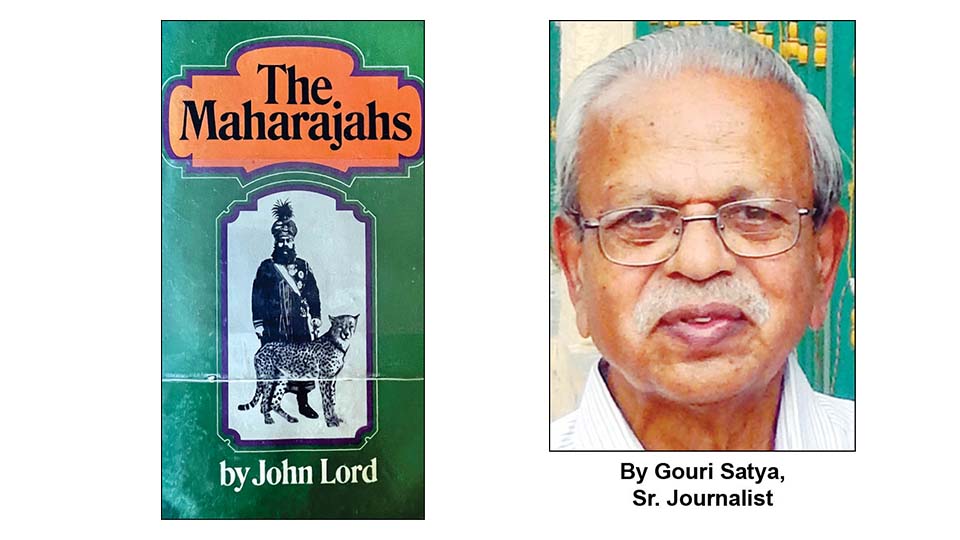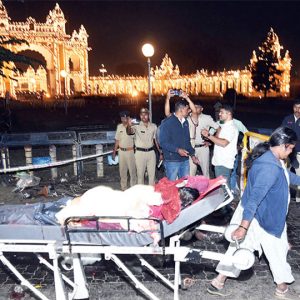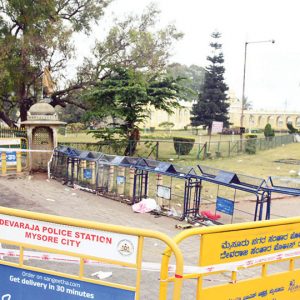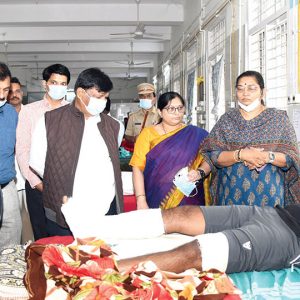Title : The Maharajahs
Author : John Lord
Year : 1971
Pages : 244+XI
Price : Rs. 500
Publisher : Random House, New York, USA
While the first book on the Indian rulers I read in the US was titled ‘The Maharaja & the Princely States of India,’ the second one that I concluded reading also relates to the Maharajas.
‘The Maharajahs’ is authored by John Lord. Born in Lancashire, England, in 1924, he was a producer for NBC in New York. He worked in India and London during the preparation for this work. It was published in 1971 in the USA.
The 241-page book covers over a dozen rulers, including Krishnaraja Wadiyar IV of Mysore. It draws ‘intimate pictures of the most famous of these fabulous Princes in their golden age when they gave to India its aura of magnificence.’
When the author says this, it is obvious that their glorious days are painted with comments that many may not endorse or look at with disdain. Take the example of the Mysore Maharaja. The author while describing the way Krishnaraja Wadiyar IV celebrated Dasara, says ‘for nine days he stayed unshaven and unwashed and his clothes were unattended.’
Such observations need to be taken with a pinch of salt. In fact, during these nine sacred Navarathri days, the Maharajas strictly remained religious and bathed twice a day, although he remained unshaven. During the period, he wore rich ceremonial clothes and offered prayers to the family deity.
The native States enjoyed semi-autonomy, which gave each Prince the freedom to develop his individuality as he pleased. Consequently, “there were monsters and near-saints among the Maharajahs, martyrs and eccentrics, heroes and shams.”
The British generally did not meddle in the internal affairs of the Native States. However, they did not tolerate a rule that was by their standards ‘depraved, incompetent or inflammatory.’ They were always reluctant to act unless matters became flagrantly public. When a Maharaja’s misdemeanours created a scandal, he was doomed. Here, John Lord makes mention of a ruler who bathed with about 40 naked ladies, who welcomed him standing on the pool steps, entered the water along with him with lamps in their hands and danced.
The author reveals the eccentricities of some of them, like the Prince of the Rampur line, Sir Syed Mohammed Hamed Ali Khan Bahadur (1875-1930). His fastidiousness extended even to the bathroom, where he spent much of the day dispensing justice and advice from a toilet seat specially designed by his chief engineer not only for comfort but to give the impression that he was formally enthroned.
The Junagadh ruler was a leading dog breeder of the Orient. He was a noteworthy sadist too. His pack numbered 800 or so at one time. But by the time of Independence, perhaps foreseeing the hard times ahead, he reduced it to a mere 300. The accommodation for his favourites among them was luxurious, consisting of a room for each one with a servant, electric light, telephone, a tiled hospital of three wards supervised by an English veterinarian with canine spectacles. He conducted the marriage of one of his dogs lavishly, inviting 50,000 guests! The upkeep of dogs cost him 13,000 dollars a month, or 11 percent of his State’s revenue.
The magnificence of the Maharajas achieved its Augustan age in the period between the visit of the Prince of Wales, who was later Edward VII in 1875-76 and his grandson, later Edward VIII in 1911-12, including the third Prince of Wales in the interim 1905-06 and again as King-Emperor in 1911. His Delhi Durbar was an assembly of the leading men in India. In all, 40,000 tents were put up in a vast area, ‘sheltering three hundred thousand people in a concentration of wealth and power not even the Tsar of Russia could equal.’ All three Princes of Wales were entertained privately and in splendour by the leading Maharajas.
Their minor eccentricities became a source of gossip and entertainment. “One conducted all his business sitting in the lavatory. Another brought two hundred and seventy automobiles. One would use only bank notes fresh from the presses of the mint and paid 10 percent extra to get them. Another filled one vast room of his Palace with packages containing the entire stock of a hardware store he had bought outright in England. The Princes pursued their professions with simple enthusiasm. One refused to have a railroad run through his territory because it offended his religion to think of passengers wolfing down beef in the dining cars. Another, enamoured by the tartan, bought Highland uniforms for his household troops perfect in detail.
One, desiring a dish of quail at the Savoy Hotel in London, caused cables to be sent to the four corners of the earth and so discovered six in Egypt, too late for dinner. Another occupied an entire floor of the same hotel, satisfying his aesthetic sense with three thousand fresh roses a day. Opening his morning paper, one heir apparent fell full shock in love with the leggy photograph of a beauty queen, located her and married her, though she was merely the 16-year-old daughter of a railroad porter from Crewe.” Such was their eccentricities and lavishness.
“The man who was a Goddess” is the title given to the chapter written about Krishnaraja Waidyar IV. It is mainly dedicated to the way the Maharaja celebrated the annual Dasara and its grandeur. His administration finds very little or no space in the narrative. To the house of Wadiyars, he writes, the story of their patroness Chamundi, though more complex, was spiritually meaningful. “To HH Sir Krishnaraja Wadyar Bahadur IV (1884-1940), devout and beloved ornament of his line, the Goddess was not only the source of all good things but the guardian of his throne, his destiny and princely soul.”
“Dasara was by no means the sole religious duty of Sri Krishnaraja, who was known as the most devout of Princes. He never ate with Europeans and it was said that he bathed after meeting them. He was a man of medium size with an expression invariably calm and a department of quiet and dignified grace. The orthodoxy and depth of Sir Krishnaraja’s beliefs and the piety of his daily life made him of all Indian Princes the ideal of a Hindu king,” he says. He is the only ruler to receive such a commendation by the British author.
Similarly, he also pays tribute to his successor, Maharaja Jayachamaraja Wadiyar, so named because of the First World War victory, and says, “The Maharaja Jaya Chamaraja Wadiyar followed his uncle’s precept by living without excess, though the fittings of his automobiles were still of ivory and gold. A man of intellectual distinction, the Maharajah was welcomed by Universities in England and America for his lectures on art and philosophy. He lived in much the same fashion as his uncle had, cultivating the arts, enjoying sport and honouring his God.”
The book is vividly descriptive. With wry wit and humour, it narrates the eccentricities and idiosyncrasies of the Native Princes, their fabulous wealth and their lavish and scandalous life.
By Gouri Satya, Sr. Journalist








I am surprised my friend Gouri Satya took the trouble to review a Kitsch ! I was rqually surprsied that Amazon sells this book at a whopping Rs.4999/- (https://www.amazon.in/The-Maharajahs/dp/0394461452).
Luckily a soft copy of the book is easily available at https://archive.org/details/in.ernet.dli.2015.460954/page/n6/mode/2up
What was galling is what the author says about Nalvadi: Three years later, in the summer of 1939, His Highness sallied forth again with a retinue of more than fifty and a train of six hundred and fifty pieces of baggage. Appropriately enough his first call was upon Pope Pius XII…….
It looks like today Historians means create History !! Truth of the matter is it was his brother the Yuvaraja who went abroad in 1939 along with his family including his son and daughter in law and visited the Pope ! It was his last trip away from home and he never returned to Mysore !
So the senior journalist Gauri Satya,has noted these:
“When the author says this, it is obvious that their glorious days are painted with comments that many may not endorse or look at with disdain. Take the example of the Mysore Maharaja. The author while describing the way Krishnaraja Wadiyar IV celebrated Dasara, says ‘for nine days he stayed unshaven and unwashed and his clothes were unattended.’
As expected, while Gauri Satya simply brushes aside the above, I tend to believe the author John Lord, who wold have gone through the archives of the British Library which have rich sources of witnessed evidences, rather than the hearsay exaggerated clap trap of Gauri Satya.
The author John Lord, clearly restates how the Bristish ruled, namely while they allowed the Wadiyars to have some independence, but they controlled all other aspects that demanded resources like developments, and hence due credit should be given to the British and the Dewans through who they kept the administrations tight overseen by the British Resident in Bangalore.
@RAJA CHANDRA COULD YOU RPOVIDE EVIDENCE-A LINK FOR THE FOLLOWING WHICH YOU ASSERTED:
“It looks like today Historians means create History !! Truth of the matter is it was his brother the Yuvaraja who went abroad in 1939 along with his family including his son and daughter in law and visited the Pope ! It was his last trip away from home and he never returned to Mysore ”
if you cannot, i believe hat the author John Lord has said, as he must have consulted, evidently he had, the India archives-masses of them, at the British Library in London.
The late Sir C P Ramaswamy Iyer, the former Dewan of Travancore and Cochin, used to visit the British Library in London, to consult these India Archives, after independence , particularly in 1950s and early 1060s, and wrote his books, which were based on facts, not like your mere conjectures.
Hey @RAJA CHANDRA
Amazon sells this at Rs 4999, based on the USD INR conversion rate. It is just about $50 which is not expensive in the West for a book which is not widely available.
You need to blame your INR for this, which is worth as much as a waste paper here in the West. Hence the West can afford to give software coding in IT projects to India, as well as hiring Indians oo man customer services in India for a number of Western countries, as they can pay peanuts-this case INR to hapless IT Techies employed as coolies and others too!
As for the Wdiyars, they were all womanisers, some of them were left impotent like SD Wadiyar, whom chased buxom woman in Musore in early 1970s. Hence, I tend to believe what the author John Lord writes.
But keep deluding yourself!!